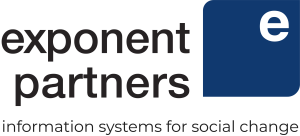Implementing Your HMIS FY 2022 Data Standard Changes
It’s that time of year again – leaves are starting to change, temperatures are getting cooler and Homeless Management Information System (HMIS) required updates are being implemented for homelessness services programs. The HMIS FY 2022 Data Standard Updates range from simple to complex – focusing on improvements around inclusivity for participants receiving services and efficiency for frontline staff entering HMIS data. System administrators are working to understand and install all of their HMIS required updates and users are testing the changes. As of October 1st, homelessness service providers will be all in – ensuring that the most up to date fields, picklist values and validation rules are being used.
Exponent Case Management’s HMIS Module
Exponent Case Management’s (ECM) HMIS Module ensures that all HMIS programs are in compliance with HMIS standards. The HMIS module was created not only with a close eye to the HUD HMIS standards, but also with input from experts in the field. We have always worked with customers who provide homelessness and housing services and now we have a standard HMIS solution for our customers no matter their HMIS program type. The ECM HMIS Module is the first HMIS solution in the Salesforce ecosystem.
Guiding Our ECM Customers Through the Changes
Exponent Partners has addressed all HMIS FY 2022 changes in the ECM HMIS module and are making sure all of our HMIS customers are fully supported during this transition. Since the updates were announced by HUD, we have kept our customers informed about the changes and the release schedule in ECM. We have provided comprehensive documentation about the updates in the module, where they are located, and who they affect. We have also explained in detail any actions that the system administrators need to take in order to be compliant with the new standards. Finally, we have met with each individual customer virtually to explain how each of the changes directly affects their system and answer any questions they have. We are always available to our customers to have further one on one meetings to support them if any issues pop up.
What has changed?
The following is a summary of the changes that impact data collection for program administrators and individual service providers. These changes are documented on page 2 in the FY 2022 HMIS Data Standards Data Dictionary under “Summary of Changes”.
Project Descriptor Data Elements
- Project Information (2.02)
- New Field: Medically Assisted living Facility.
- Rationale: This field was requested by HOPWA to determine if the HOPWA project is an assisted living facility.
- Applicability: All projects must answer this field, but only HOPWA projects would answer “Yes”.
- Funding Sources (2.06)
- New response options added to field 1 Funding Sources.
- HUD: CoC – Joint Component RRH/PSH
- HUD: HOME
- HUD: HOME (ARP)
- HUD: PIH (EHV)
- Rationale: Responses added to support programs affected by the American Recovery Plan.
- Applicability: All projects.
- New response options added to field 1 Funding Sources.
Universal Data Elements (applicable to all projects)
- Race (3.04)
- Response option labels updated in field 1 Race.
- American Indian, Alaska Native, or Indigenous
- Asian or Asian American
- Black, African American, or African
- Rationale: Response labels provide more inclusivity and representative language for all demographics.
- Response option labels updated in field 1 Race.
- Ethnicity (3.05)
- Response Option labels updated in field 1 Ethnicity.
- Non-Hispanic/Non-Latin(a)(o)(x)
- Hispanic/Latin(a)(o)(x)
- Rationale: Response labels provide more inclusivity and representative language for all demographics.
- Response Option labels updated in field 1 Ethnicity.
- Gender (3.06)
- Field type changed from a single picklist to a multi-picklist and response option labels updated in field 1 Gender.
- A gender other than singularly female or male (e.g. non-binary, genderfluid, agender, culturally specific gender)
- Transgender
- Questioning
- Rationale: Response labels provide actual gender options and more inclusionary and representative options.
- *Please note that “Questioning” refers to a participant who is searching and actively trying to understand their own gender identity. This is different from “Client doesn’t know” where the participant cannot answer the question.
- Field type changed from a single picklist to a multi-picklist and response option labels updated in field 1 Gender.
Common Program Specific Data Elements (applicable to all projects)
- Mental Health Problem (4.09)
- Field label changes in field 1 Mental Health Problem.
- Mental Health Disorder
- Rationale: Previous language of “Mental Health Problem” was outdated.
- Field label changes in field 1 Mental Health Problem.
- Substance Abuse (4.10)
- Field label change in field 1 Substance Abuse.
- Substance Use Disorder
- Rationale: Previous language of “Substance Use” was outdated.
- Field label change in field 1 Substance Abuse.
- Coordinated Entry Event (4.20)
- Additional referral response options.
- Referral to emergency assistance/flex fund/furniture assistance
- Referral to Emergency Housing Voucher (EHV)
- Referral to a special purpose voucher (homeless targeted units)
- Rationale: To collect additional referral information in response to pandemic relief.
- Additional referral response options.
Federal Partner Program Specific Data Elements
- New data element: Prescribed Anti-Retroviral (W6)
- New fields related to prescription anti-retrovirals: Has the participant been prescribed anti-retroviral drugs?
- Rationale: To document progression of any medication prescribed during a HOPWA-funded project participation.
- Applicability: All HOPWA-funded projects.
- Medical Assistance Data Element (W3)
- New field (and dependent field): Receiving Public HIV/AIDS Medical Assistance.
- Rationale: Track whether or not a participant is receiving Ryan White-funded medical or dental assistance.
- Applicability: All HOPWA – funded projects.
- New data element: Well-being Data Element (C1)
- New fields:
- Client perceives their life has value and worth.
- Client perceives they have support from others who will listen to problems.
- Client perceives they have a tendency to bounce back after hard times.
- Client’s frequency of feeling nervous, tense, worried, frustrated, or afraid.
- Rationale: Understand feelings of quality of life for the participants in homelessness programs.
- Applicability: HUD CoC: PH – Permanent Supportive Housing.
- New fields:
- New Data Element: General Health Status (R7)
- New field: General Health Status.
- Rationale: Understand participant’s feelings about their own health.
- Applicability:
- HUD: HUD-VASH – Required for HUD/Vash Other
- HHS: RHY – All projects except for Street Outreach
- HUD: CoC – Permanent Supportive Housing
- New Data Element: Moving on Assistance Provided (C2)
- New field: Moving on Assistance Provided.
- Rationale: To better understand the extent to which PSH clients participate in Moving On initiatives.
- Applicability: HUD CoC: PH – Permanent Supportive Housing.
- New Data Element: Youth Education Status (C3)
- New fields:
- Most Recent Educational Status.
- Current Educational Status (dependent field).
- Rationale: To get more details about youth educational situations.
- Applicability: HUD: CoC – Youth Homeless Demonstration Program
- Transitional Housing
- PH – Permanent Supportive Housing
- Services Only
- Other
- PH: Rapid Re-housing
- New fields:
- Financial Assistance (V7)
- Added/Updated Financial Type responses for Field 1 (collapsed 2 responses and added a new one):
- General housing stability assistance.
- Food assistance.
- Rationale: VA requested more efficient data collection.
- Applicability: VA: SSVF – required for Rapid Re-housing and Homelessness Prevention projects.
- Added/Updated Financial Type responses for Field 1 (collapsed 2 responses and added a new one):
- HP Targeting Criteria (v3)
- Significant restructure of fields and responses. Element re-named to remove “SSVF” as the element may become applicable for other partners. Removed scoring that were embedded in the answers. Everything is a dependency on field 1. Is Homelessness Prevention targeting screener required?.
- Rationale: Changes made to improve validity and reliability of results.
- Applicability: VA: SSVF – Homelessness Prevention.
- Formerly a Ward of Juvenile Justice System (R12)
- Updated field label for Dependent Field A.
- If Yes for “Formerly a Ward of Juvenile Justice System”
- Rationale: Corrected from previous version.
- Applicability: HHS: RHY – Collection required for all components except for Street Outreach.
- Updated field label for Dependent Field A.
- Family Critical Issues (R13)
- Update response labels for Fields 11 and 21.
- 11. Mental Health Disorder – Family member
- 12. Alcohol or Substance Use Disorder – Family member
- Rationale: Previous language was outdated.
- Applicability: HHS: RHY – Required for all components except Street Outreach.
- Update response labels for Fields 11 and 21.
- RHY Service Connections (R14)
- Update response labels for Fields 17 and 18.
- 17. Substance use disorder treatment
- 18. Substance use disorder Ed/Prevention Services
- Rationale: Previous language was outdated.
- Applicability: HHS: RHY – Required for all components.
- Update response labels for Fields 17 and 18.
System Logic Updates
- Project Exit Date (3.10)
- If auto-exit is offered, there must meet certain requirements:
- A standard to auto-exit a client after a certain length of absence from a program.
- A residential project client’s exit date would be the last date the client appeared at the program.
- A non-residential project client’s exit date must represent the last day a contact was made or a service was provided.
- If auto-exit is offered, there must meet certain requirements:
- Relationship to Head of Household (3.15)
- System logic added to ensure that there is at least one, but not more than one, HoH for each enrollment.
- Income and Sources (4.02) and Non-Cash Benefits (4.03)
- When a client ages into adulthood (18 yo), treat income updates as “update”
- Housing Move-in Date (3.20)
- Move-in date can only be on or between project start date and project exit date.
- T-Cell and Viral Load (W4)
- Applicability is for all household members with HIV/AIDS instead of only clients funded in a HOPWA project presenting with HIV/AIDS.
- Pregnancy Status (R10)
- Remove limitation of applicability to only female participants
Continuous Improvement
We have enjoyed working with our customers toward a smooth and efficient transition to the updated HMIS data collection standard. We look forward to continuing to improve our module both from a HUD standard point of view as well as a practical and operational perspective. Staying up to date with the HMIS standard will always be our top priority.
Interested to learn more about our HMIS module and see ECM in action? Sign-up for one of our biweekly webinars!



